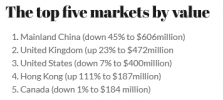- Location
- Deep South of Cambridgeshire
You are using an out of date browser. It may not display this or other websites correctly.
You should upgrade or use an alternative browser.
You should upgrade or use an alternative browser.
Old Aussie Wines - are they the villains we sometimes make them out to be? (clue: No!)
- Thread starter Alex Lake
- Start date
- Location
- Holmfirth
That’s the kind of wine that used to be discussed quite a lot on here 10-15 years ago, before the Burgophiles and the Italiban took over.
Incidentally, Alex, why “surprisingly” fab? Good old Aussies are as good as good old French wines etc.
Incidentally, Alex, why “surprisingly” fab? Good old Aussies are as good as good old French wines etc.
- Location
- London
I know a distinguished Antipodean wine writer who believes that Australasia is fundamentally unsuited to the production of unfortified wines, which is an interesting perspective.Good old Aussies are as good as good old French wines etc.
- Location
- London, England
ABV, Alex?
- Location
- Dorset, England
Interesting but flawed. IMHO, of course.I know a distinguished Antipodean wine writer who believes that Australasia is fundamentally unsuited to the production of unfortified wines, which is an interesting perspective.
- Location
- London
I don't know enough to have a view but I do know that it is a view which provides considerable career challenges.Interesting but flawed. IMHO, of course.
- Location
- Oxfordshire
And benefits. Like being a Burgundian wine writer who believes the region is fundamentally unsuited to producing anything but sparkling wines, it must cut down the amount of wines one needs to taste considerably.
The Amon Ra 05 has been lovely whenever I've tried it, which hasn't been for a decade or more. There must be some bottles of it hiding from me in my cellar.
The Amon Ra 05 has been lovely whenever I've tried it, which hasn't been for a decade or more. There must be some bottles of it hiding from me in my cellar.
- Location
- Northampton
I think I have a few bottles of this in the cellar - maybe a candidate for next year’s Australia WIMPS…
- Location
- Edmonton, Canada
I've only had a 2005 Amon Ra and, along with a 2005 Carnival of Love, liked them at the time. Like Eric it was about a decade ago when they were young. However at the time I did not fancy their chances of aging gracefully. It seems I may have been wrong. It's not that I don't think Australasian wines do not age and I have quite a number of them at 20 to 25 years of age, the most recent being a 2000 Tyrrell's Vat 11 'Baulkam Shiraz' earlier this year. It was the plush nature of the wines and their seeming lack of structure that made me think that way.
With wine you never know what will develop and how often do we hear the lament of having drunk them too young.
Mahmoud.
With wine you never know what will develop and how often do we hear the lament of having drunk them too young.
Mahmoud.
Tom Cannavan
Administrator
That’s the kind of wine that used to be discussed quite a lot on here 10-15 years ago, before the Burgophiles and the Italiban took over.
I honestly don't think that's just a forum thing: I think it's a wider issue. I used to write about Amon Ra, Coppermine Rd, The Armagh, etc. very regularly, because I was always getting a chance to taste them with visiting winemakers or their distributors. It's literally years since I saw Ben Glaetzer over here, whereas 10 or 15 years ago he made regular, maybe annual visits. I think the distribution, availability and prominence of those higher end Aussie wines is nowhere near what it was back then.
- Location
- Holmfirth
One possibly relevant factor is that we in the UK were paying so little for top Australian wines, compared to what they fetched in their home market.I honestly don't think that's just a forum thing: I think it's a wider issue. I used to write about Amon Ra, Coppermine Rd, The Armagh, etc. very regularly, because I was always getting a chance to taste them with visiting winemakers or their distributors. It's literally years since I saw Ben Glaetzer over here, whereas 10 or 15 years ago he made regular, maybe annual visits. I think the distribution, availability and prominence of those higher end Aussie wines is nowhere near what it was back then.
- Location
- Edmonton, Canada
And possibly got tired of the style if so many of them ..... ?One possibly relevant factor is that we in the UK were paying so little for top Australian wines, compared to what they fetched in their home market.
- Location
- U.K.
[Mis-posted!]
Last edited:
- Location
- Herefordshire
BG wines are excellent … not sure why being good is surprising!
- Location
- Dorset, England
My TN 3 June 2013 - Dark; classic, unmistakably Barossan Shiraz; bold, lush massive fruit but plenty of vitality. Powerful finish. Good now & will drink effortlessly during the next decade+.The Amon Ra 05 has been lovely whenever I've tried it, which hasn't been for a decade or more. There must be some bottles of it hiding from me in my cellar.
I have some Glaetzer-Dixon Mon Père Shiraz (Tasmania) made by Ben’s brother, both son’s of Colin, nephews of John. The Glarrzer family are Aussie winemaking royalty. On the possible list for Oz Wimps, 2022.
Last edited:
Tom Cannavan
Administrator
One possibly relevant factor is that we in the UK were paying so little for top Australian wines, compared to what they fetched in their home market.
It's the major factor I'd say. I've reported here before that more than one Australian winemaker has told me the UK is no longer a key market because selling at the right price is too hard, and they are focusing their marketing efforts elsewhere (including Chinese and other Asian markets that are much closer to them).
A few have said that if it wasn't for the fact that it is still regarded as the most influential market, they wouldn't bother with the UK at all.
- Location
- Dorset, England
It’s been like that for a number of years. Seppelt is a good example: a large producer which declines to engage with UK market. Their Drumborg Tiesling is in top 3 from Oz, IMO. I managed to arrange for a relative to bring back a solitary bottle, along with an A. Rodda Smith’s V. Chardonnay.
Last edited:
- Location
- Deep South of Cambridgeshire
- Location
- Deep South of Cambridgeshire
15.5%ABV, Alex?
It did not seem like that - at least to begin with. I found that it hit a sweet spot about 30 mins after opening - where it had that self-contradiction quality of lightness (maybe freshness?) and power, but after a bit longer, it began to sink (a bit like a soufflé?!) and, while still good, wasn't quite "fab" IMHO. I wonder if it might be a temperature related thing.
By coincidence we're having a mini vertical of Dead Arm at a dinner tonight - 1997 and 2003. This is because a friend who has stayed faithful to the style wanted a buy-in from my cellar, and I still have a certain amount of this type of wine - that I generally pass over when looking for something to drink. As an occasional treat, I think I'm happy to dip my toe back into the water. Goodness knows, perhaps those 1998 Chateauneufs will be next!
Last edited:
- Location
- Deep South of Cambridgeshire
Not fab, but this seems to be the mid-week drinking thread (maybe edit the title Alex?). Still not bad...
Maybe I will, but perhaps not in that direction!
Is that an issue specifically with Australian wines (i.e. Brits aren't prepared to pay the premium that they do for e.g. big names from France) or are Brits generally regarded as tighter than consumers from other countries?the UK is no longer a key market because selling at the right price is too hard
I remember seeing the Amon-Ra at Oddbins under Holborn Viaduct along with things like Dead Arm in the late 1990s when I was starting to take an interest in wine, and thinking they were the coolest, most desirable things in the shop with all those Parker points and the brooding black packaging...
Tom Cannavan
Administrator
Nick, I think many of us felt that about those wines 20 years ago, and I honestly don't know whether we have changed, they have, or it is just as I describe: the wines are not so prominently marketed and have slipped off the radar somewhat.
In terms of the UK verses other markets, we are not as bad as Germany which wants really cheap wines, but we are a tight market; a very price conscious and of course, competitive one where 50p up or down can make or break a wine, epsecially in a supermarket setting.
In terms of the UK verses other markets, we are not as bad as Germany which wants really cheap wines, but we are a tight market; a very price conscious and of course, competitive one where 50p up or down can make or break a wine, epsecially in a supermarket setting.
- Location
- London
I notice on the back label it says Late Harvest Barossa Shiraz - what could possibly go wrong ?
And testament to the winemaking that it didn't.
And testament to the winemaking that it didn't.
- Location
- Deep South of Cambridgeshire
So where are the biggest markets for things like Dead Arm, Amon Ra, Mount Edelstone, Grange, etc?
Edit: Found this The top five export markets for Australian wine in 2021 but its for all wines, not just the super-premiums.

Edit: Found this The top five export markets for Australian wine in 2021 but its for all wines, not just the super-premiums.

- Location
- London
In my experience a lot of big Australian wines age, but don’t necessarily age well, as in improve, they just evolve over time into something different - some from fruity monsters to amorphous blobs.
But some do age particularly well, the best example I can remember is Mount Mary Quintet. The Cullen Diana Madeline is quite a nice wine but you can drink it from the get go and it doesn’t really improve much; neither does it have the complexity of a good Bordeaux. Leoville Barton blows it away.
It used to be said that you need to wait on your Grange for nine years before drinking. I have found some Granges to have a narrow drinking window, unlike, say, Bordeaux. The last one I had was the 1989, which tasted like prune juice. I left it 5-10 years too late.
The only things I have left now are a few Granges, a couple of 707s, a couple of 98 Riddochs (highly volatile) and a few Rockford Basket Press from the early 90s. I occasionally drink them for a change of scenery and they are expensive rarities these days.
I served a 1996 Grange against a 1998 Pape Clement rouge this year to some friends. They were initially wowed by the bigness of the Grange but over the evening preferred the finesse of the Pape Clement.
But some do age particularly well, the best example I can remember is Mount Mary Quintet. The Cullen Diana Madeline is quite a nice wine but you can drink it from the get go and it doesn’t really improve much; neither does it have the complexity of a good Bordeaux. Leoville Barton blows it away.
It used to be said that you need to wait on your Grange for nine years before drinking. I have found some Granges to have a narrow drinking window, unlike, say, Bordeaux. The last one I had was the 1989, which tasted like prune juice. I left it 5-10 years too late.
The only things I have left now are a few Granges, a couple of 707s, a couple of 98 Riddochs (highly volatile) and a few Rockford Basket Press from the early 90s. I occasionally drink them for a change of scenery and they are expensive rarities these days.
I served a 1996 Grange against a 1998 Pape Clement rouge this year to some friends. They were initially wowed by the bigness of the Grange but over the evening preferred the finesse of the Pape Clement.
Last edited:



